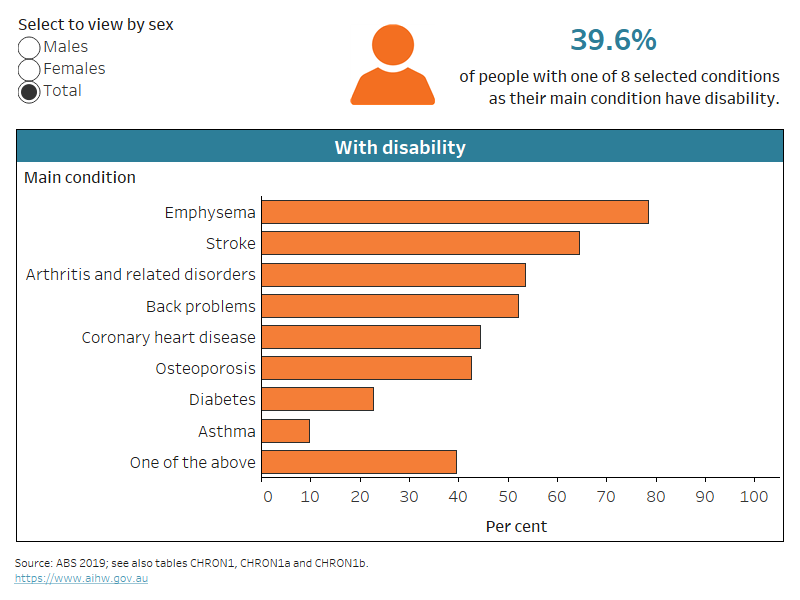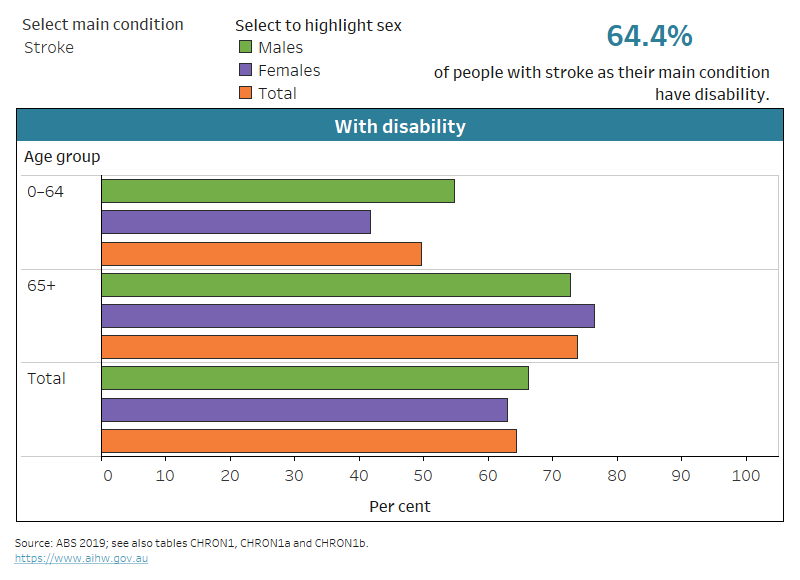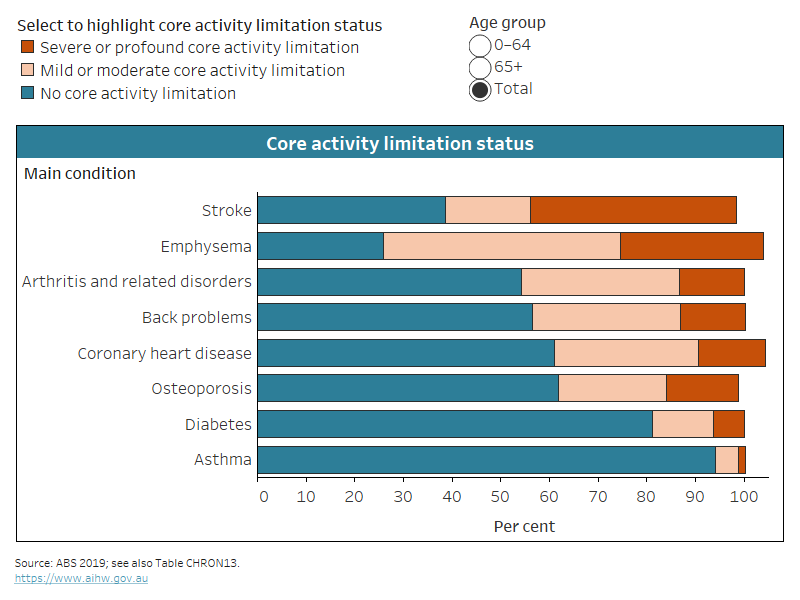Chronic conditions and disability
Health conditions and disability
78% of people with emphysema as their main condition in 2018 had disability, as did 64% of people with stroke.
Core activity limitation
42% of people with stroke as their main condition had severe or profound core activity limitation in 2018, as did 29% of people with emphysema.
Age as a factor for disability and health conditions
One in 3 (34%) people aged 65 and over with asthma as their main condition had disability, compared with 7% of those aged under 65 (in 2018).
On this page:
Introduction
Chronic health conditions are often associated with some level of disability. This section explores how many people with one or more of 8 selected chronic conditions have disability, and how severe this disability is.
Chronic conditions covered in this section are:
- coronary heart disease
- stroke
- diabetes
- arthritis and related disorders
- back pain and problems
- osteoporosis
- asthma
- emphysema.
These chronic conditions were selected because they are common, pose significant health problems, have been the focus of recent AIHW surveillance projects and, in many instances, action can be taken to prevent their occurrence. See AIHW chronic disease for more information.
What are chronic conditions?
Chronic conditions are generally characterised by their long-lasting and persistent effects. They are not usually immediately life threatening but are a common cause of premature death (AHMAC 2017). They have complex and multiple causes, usually come on gradually, and become more common with age. Chronic conditions are often associated with reduced quality of life and limitations in daily living.
Chronic health conditions are the leading cause of illness, disability and death in Australia. About 5.5 million people in Australia are affected by at least one of the 8 chronic health conditions covered in this section. For most (3.7 million), the condition is reported as their main health condition (the condition causing them the most problems) (ABS 2019).
Chronic conditions often coexist with some form of disability:
- half (50% or 2.8 million) of people with at least one of the selected chronic conditions also have disability
- 40% (or 1.5 million) of people who have one of the selected chronic conditions as their main condition also have disability (ABS 2019).
It cannot be assumed that disability is a consequence of a chronic health condition. As such, this section describes only the associations between disability and the selected chronic conditions and does not describe a causal relationship.
What is the relationship between health conditions and disability?
There is a 2-way relationship between health conditions and disability. People with a health condition are more likely to develop disability, and people with disability are more likely to develop a health condition.
Not everyone with a health condition will develop disability, and people with the same health condition who have disability may also experience different forms of disability or severity of disability. See ‘Defining disability’ for more information on the relationship between health conditions and disability.
Data note
Data on this page are sourced from the Australian Bureau of Statistics (ABS) 2018 Survey of Disability, Ageing and Carers (SDAC). For more information about the SDAC, including the concepts of disability, disability severity, disability groups, and remoteness categories used by the SDAC, see ‘Data sources’.
The SDAC collects data on long-term health conditions. For people who report more than one long-term condition, the condition causing the most problems is identified as the main condition. However, because the SDAC is designed to estimate the prevalence (or rate) of disability – not the prevalence of health conditions in a population – the prevalence of long-term conditions is generally lower than for other surveys. Also, information based on self-reported data relies on survey participants being aware of and accurately reporting their health conditions.
Unless otherwise indicated, all data on this page refer to 2018.
Prevalence of disability within selected chronic conditions
The prevalence of disability for each selected chronic condition, as a main condition, varies widely (Figure CHRONIC.1). Among selected chronic conditions, people with asthma are the least likely to have disability (9.8% or 81,000). People with emphysema (78% or 44,000) or stroke (64% or 55,000) are the most likely to have disability.
Figure CHRONIC.1: Prevalence of disability among people with selected chronic conditions, by main condition and sex, 2018
The chart shows a higher proportion of people with back problems as their main chronic condition have disability (52%) than those with diabetes (23%).

Note: Restricted to people with one or more of the following long-term conditions: arthritis and related disorders, asthma, back problems (dorsopathies), coronary heart disease (including angina and myocardial infarction (heart attack)), diabetes, emphysema, osteoporosis, and stroke.
Source data tables: Data tables – Chronic conditions and disability. View data tables
For most of the 8 chronic conditions there is little difference between males and females in how likely a person is to have disability (Figure CHRONIC.1). The largest difference is for people with emphysema – 86% (or 21,000) of females with emphysema also have disability, compared with 70% (or 23,000) of males.
The prevalence of chronic conditions and disability both increase with age (see ‘Prevalence of disability’, and AIHW chronic disease). Reflecting this, older people (aged 65 and over) with each selected chronic condition are generally more likely than younger people (those aged under 65) to have disability (Figure CHRONIC.2).
While the prevalence of disability within chronic conditions generally increases with age, some chronic conditions are more likely associated with disability at all ages. The largest increases in disability within a chronic condition as people get older occur for:
- asthma (rising from 7.0% or 53,000 for those aged under 65, to 34% or 28,000 for those 65 and over)
- back problems (rising from 44% or 316,000 to 69% or 234,000).
Figure CHRONIC.2: Prevalence of disability among people with selected chronic conditions, by main condition, age group and sex, 2018
The chart shows people aged under 65 with stroke as their main condition are less likely (50%) to have disability than people aged 65 and over (74%).

Notes:
* Relative standard error of 25–50% and should be used with caution.
- Restricted to people with one or more of the following long-term conditions: arthritis and related disorders, asthma, back problems (dorsopathies), coronary heart disease (including angina and myocardial infarction (heart attack)), diabetes, emphysema, osteoporosis, and stroke.
- The category ‘0–64’ has a relative standard error greater than 50% and is considered too unreliable for general use for males with osteoporosis and females with coronary heart disease or emphysema. Therefore, these categories are not shown in this figure.
Source data tables: Data tables – Chronic conditions and disability. View data tables
Level of core activity limitation associated with selected chronic conditions
The level of core activity limitation associated with the 8 selected chronic conditions varies. Some conditions have lower levels of impact (in terms of people’s need for assistance in carrying out core activities), and others a high level.
What is core activity limitation?
The severity of a person's disability is based on the degree to which the core activities of daily living (self-care, mobility and communication) are affected. ‘No core activity limitation’ includes people who have disability but no specific limitation or restriction, those who have disability related to restrictions in schooling or employment, and those who have a long-term health condition but no disability.
Of the selected chronic conditions, stroke is associated with the highest likelihood of severe or profound core activity limitation:
- 42% (or 37,000) of people with stroke as their main condition have severe or profound core activity limitation
- 17% (or 15,000) have mild or moderate core activity limitation
- 39% (or 33,000) have no core activity limitations, but may still have disability not related to core activities.
Of the selected chronic conditions, asthma is associated with the lowest level of core activity limitation:
- 1.5% (or 13,000) of people with asthma as their main condition have severe or profound core activity limitation
- 4.6% (or 38,000) have mild or moderate core activity limitation
- 94% (782,000) have no core activity limitation, but may still have disability not related to core activities (Figure CHRONIC.3).
Figure CHRONIC.3: Level of core activity limitation, by main condition and age group, 2018
The chart shows 42% of people with stroke as their main condition have severe or profound core activity limitation, and 29% of people with emphysema.

Notes:
* Relative standard error of 25–50% and should be used with caution.
- Restricted to people with one or more of the following long-term conditions: arthritis and related disorders, asthma, back problems (dorsopathies), coronary heart disease (including angina and myocardial infarction (heart attack)), diabetes, emphysema, osteoporosis, and stroke.
- Figures are rounded and discrepancies may occur between sums of the component items and totals because of ABS confidentiality and perturbation processes. Numbers may not add up to 100 per cent due to rounding.
- Core activity limitation levels for people aged 0–64 with emphysema, coronary heart disease, or osteoporosis are not shown due to high level of uncertainty in the data.
Source data tables: Data tables – Chronic conditions and disability. View data tables
Where can I find out more?
- Data tables for this report.
- ABS Disability, Ageing and Carers, Australia: Summary of Findings, 2018.
- AIHW Chronic conditions and disability 2015 report.
- AIHW Chronic disease overview page.
ABS (Australian Bureau of Statistics) (2019) Microdata: disability, ageing and carers, Australia, 2018, ABS cat. no. 4430.0.30.002, ABS, AIHW analysis of TableBuilder data, accessed 14 October 2021.
AHMAC (Australian Health Ministers' Advisory Council) (2017) National Strategic Framework for Chronic Conditions, AHMAC, Australian Government, accessed 4 August 2021.


